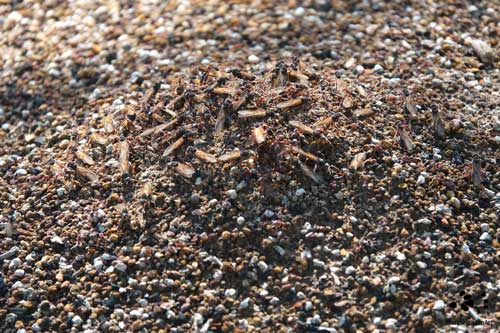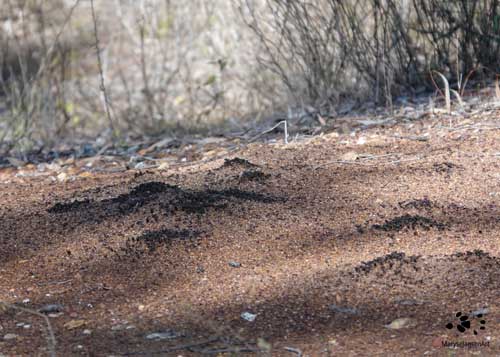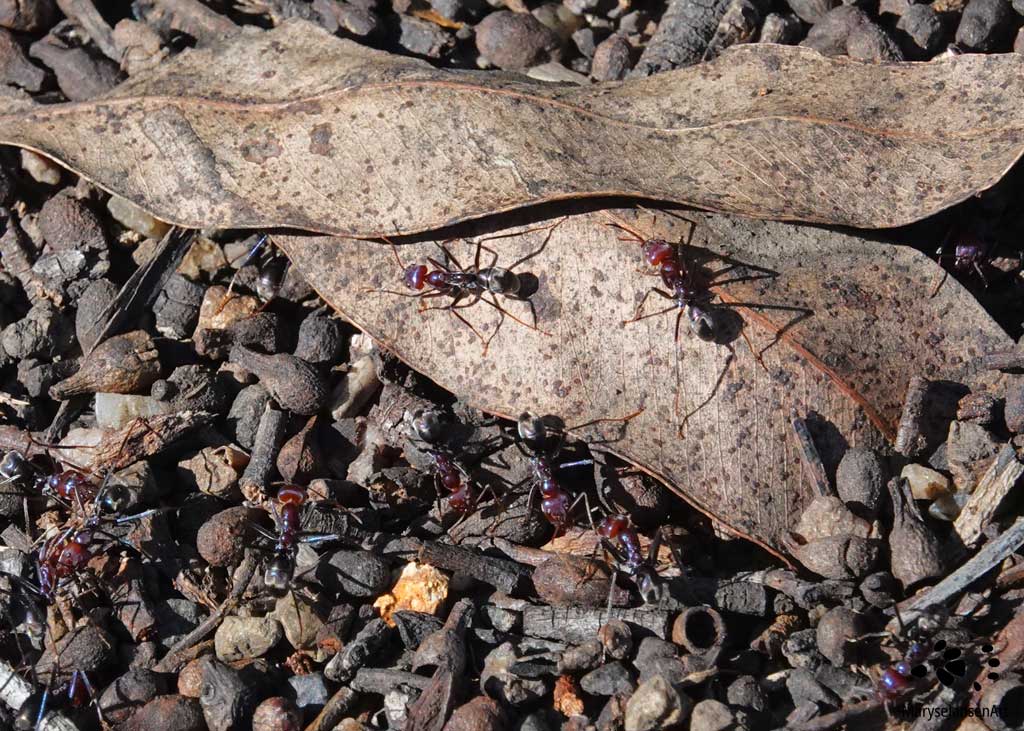Wildlife Photography with marysejansenart
An aggressively natured bunch and their mass reproductive event

Table of Contents
Meeting Meat Ants
‘Ouch!’, I look at my foot. My friend laughs: ‘Those are Meat Ants!’, she said, ‘don’t worry, they have a nasty bite but don’t sting, so the pain doesn’t last long.’ After this first encounter with these insects I quickly learned not to stand still for long nearby a Meat Ant nest, and preferably not to wear sandals in their territory. This species will defend their nest aggressively against any intruders and they have a tendency to climb your legs and bite when you come to close.
Meat Ants, also known as Gravel Ants or Southern Meat Ants, are found throughout large parts of Australia and are especially abundant in the south-west and the south-east of the continent, with the exception of Tasmania and other outlying islands.
Looks and Diet
The ants are a dark purplish colour and have a red head. They measure 6-12mm. The workers are smaller and the Queens are larger. The Queens are mostly black. From what seems a safe distance from the nest, seeing that there are no ants crawling on the ground around my feet, I peer through my camera.
It is hard to see from a distance as the creatures are quite well camouflaged on the gravel, but my zoom lens reveals that the surface of the mound is covered in ants. Take a close look at the featured image: while the two ants are easy to see on the dried leaf, there are a whole lot more of them visible in the image! How many can you spot?
When they leave the nest, they follow their foraging trails in search of food. Meat Ants love to feed on honeydew secreted by sap-sucking insects that live in the trees. They will also honour their ‘sweet tooth’ by feeding on other sweet things they can find, such as the nectar of a flower. Furthermore, they prey on insects and other animals both dead and alive. Their behaviour of stripping the meat of dead animals has given them their name. These ants will even eat fresh guano – which are the excretions from bats or seabirds. Meat Ants have also been found to be able to consume Cane Toads, without being affected by their toxins!

Meat Ant nests
The nests are easy to recognize: they look like a large oval-shaped mound. These mounds are not high but they can be one to two metres wide! Typically, the surface of the mound is covered with gravel, but you may also see sand, small pebbles and pieces of dead vegetation. The ants build these nests in open spaces, with direct exposure to the sun for warmth. As a consequence, I often spot them in the middle of or alongside a walking trail, even in urban parklands. A nest may have 20-35 entrance holes of varying width.
While taking photos and pondering on their foraging behaviour, the ants have found me and I am suddenly startled by a fierce bite in my ankle! I quickly flick a couple of ants from my shoes … time to move on!
Meat Ants are polydomous. This means that a colony occupies more then one nest. When there is space, these insects can build enormous colonies! They can cover several hectares of land, building numerous nests that are connected by their trails. A colony can house tens of thousands up to hundreds of thousands of ants! This construction enables them to efficiently expand their foraging range. Interestingly, the ants show aggression towards ants from a different nest in the same colony, but not towards their own nest mates.
The Nuptial Flight
I am walking a bush trail in Central Queensland and it is obvious that Meat Ants reign here. There are mounds everywhere! But something is different today …. From a distance I see black blotches on the mounds. I am not even close yet, and already I am being attacked by a trail of Meat Ants! I walk faster to not give them the chance to climb on my feet and legs, while trying to see what is going on at the nest. Again, I let the zoom lens help me get a better look, but I am seriously challenged. The ants won’t leave me alone, even from a distance!

I have to keep moving! I can see what the black blotches are though. They are congregations of alates: the reproductive males and females. These are winged ants that are getting ready for their Nuptial Flight! Nuptial Flight is a term that describes the phase in the reproduction of the ants when virgin queens mate with males and then land to start a new colony.
The ants use environmental cues to synchronize their flight with those from other nests. The alates emerge after rain. They sit on the top of the nest until they have warmed up enough to be able to fly. When they all take-off at once there is a better chance of being able to mate with an ant from a different nest, thus increasing the gene pool. Also there is safety in numbers when predators are nearby. Echidnas love to feast on the winged females. Other predators include various species of birds, lizards, insects, a blind snake and a spider.
Usually the event occurs in spring. But a great drought has apparently delayed the event. After 8 months, finally this area received a big all-day downpour yesterday and that must have triggered the ants to fly. The whole area is electrified with their buzzing energy. The ants that are not flying are running around much faster then normal and are more aggressive, trying to ensure that their reproductive relatives get the chance to fly and mate.
It’s an amazing thing to witness! It’s quite exhausting too, as I basically have to keep moving at a fast pace to avoid being bitten! I realize how special this moment is though, therefore I make my best efforts to get some photos and some footage before I retreat to a safer place, so that I can share it with you! Check out the buzz in the footage in the Bonus Episode of ‘Come for a walk in the Australian Bush’ below:
If you are interested in purchasing a print of ‘Meat Ants’ or would like to see what the image looks like on the various merchandise products, please head to my shop.
Read about Green Tree Ants here.


